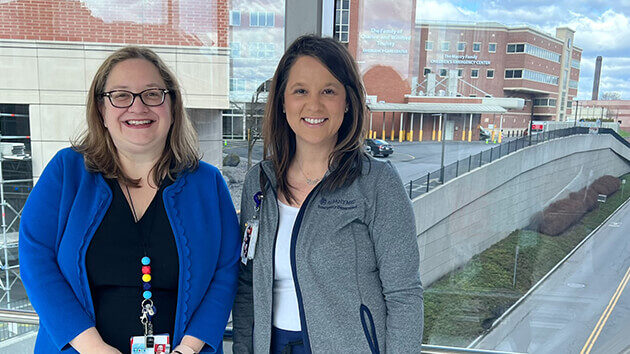Raising Awareness: 5 Questions with Albany Medical Center Experts During Child Abuse Prevention Month

April is National Child Abuse Prevention Month, raising awareness of the importance of families and communities working together to prevent child abuse and neglect.
National statistics tell one piece of the story regarding a problem that impacts communities everywhere. 618,000 victims of child abuse were reported across the U.S. in 2020, or 8.4 victims per 1,000 children in the population.
At Albany Medical Center, resources are available to support patients and families in cases of child maltreatment and neglect. These efforts are led by Rebecca Butterfield, MD, section chief, Child Abuse Pediatrics, and Kirsten Morrissey, MD, medical director, Sexual Assault Forensic Examiner Program. We focused on five questions with these two experts to help raise awareness about a sensitive yet important topic.
1. What are some of the risk factors that are often associated with cases of child maltreatment or neglect?
Social determinants of health – the conditions in the environments in which people are born, live, learn, work, play, worship and age – play a significant role in child abuse cases. Risk factors including substance abuse, a lack of financial resources, and inadequate housing often play a contributing role, as does violence between partners.
“One key to reducing cases of child maltreatment can be screening for intimate partner violence in all health care settings,” Dr. Butterfield said. “For example, when a partner speaks with their primary care physician about violence committed by their partner against them, that’s an opportunity for that provider to talk about prevention and safety, and that can be a key asset.”
Research shows cases of child maltreatment in as high as 60 percent of families where spousal abuse also occurs.
2. How are cases of child maltreatment and neglect identified?
“Outside of the hospital setting, so many in our community play a key role in identifying these cases,” Dr. Butterfield said. “Teachers and school officials are most often the ones who identify potential cases of abuse or maltreatment and refer them for further examination.”
Dr. Morrissey emphasizes that early recognition plays an important role in getting assistance to a child in need.
In New York, a statewide toll-free number is available to report a suspected case of abuse or maltreatment of a child.
3. Do the efforts to identify, educate and prevent cases of child abuse reach everyone in need of support?
The difficult answer, even with education and awareness efforts in most communities, is no.
“Many victims of child abuse are not identified,” Dr. Butterfield said. “It is, in many ways, a hidden epidemic.”
For starters, the Covid-19 pandemic has led to much discussion of this topic. For example, the number of documented cases of child abuse and neglect seemingly decreased in 2020, but contributing factors such as children not being in school have skewed the numbers.
“We know there are cases we never see,” Morrissey said, pointing to studies that show that many of the risk factors for abuse cases have increased since March 2020.
4. What work is done at Albany Medical Center to support child abuse victims and families?
Resources and services are available to children and families 24/7. Universal screening tools are learned and used across the hospital and in clinics to ensure proper screenings for potential cases of child maltreatment. When appropriate, forensic nurse examinations are carried out in the Massry Family Children’s Emergency Center and care and support for children and families is coordinated to ensure that victims receive the help they need.
“Supporting a victim of child maltreatment takes a multidisciplinary approach,” Dr. Butterfield said. “This can include Child Protective Services (CPS), parenting resources, mental health resources through the county, and more.”
5. What are some ways to increase the focus on this important topic?
Through the Albany Medical Center Child Abuse Medical Provider program, education and training is provided to hospital and community providers to give them knowledge that helps them better respond to suspected child abuse and neglect.
Awareness efforts and talking about the topic through the month of April helps to shine some light for the public on what Dr. Morrissey calls “an uncomfortable topic.” She stresses the importance of focusing on the bigger picture and helping patients they see by connecting them to social workers and resources that can help.
“The more education, the better,” Dr. Morrissey said.